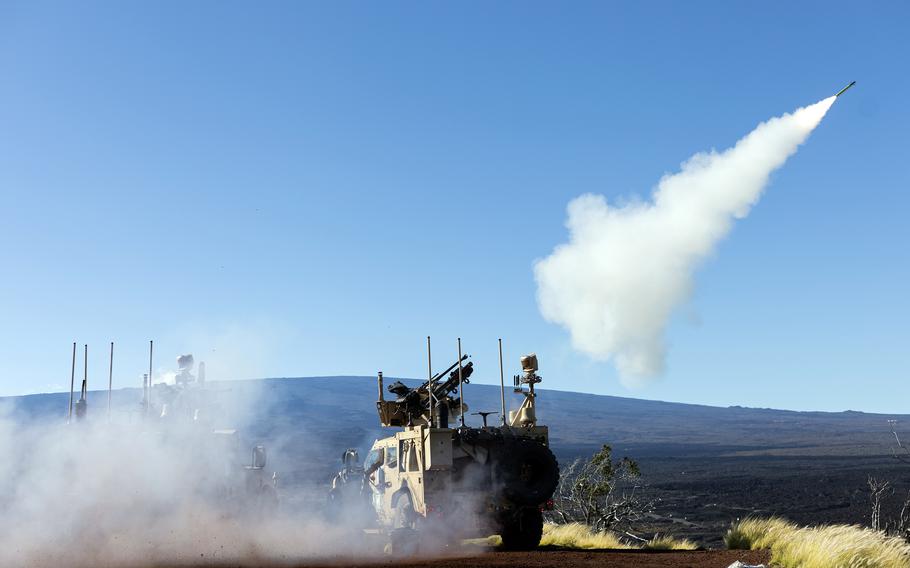
A Marine Air Defense Integrated System vehicle fires a Stinger missile at a target drone at Pohakuloa Training Area, Hawaii, Jan. 25, 2025. (Jacqueline Parsons/U.S. Marine Corps)
POHAKULOA TRAINING AREA, Hawaii — Marines used their new hunter-killer system to blast dozens of target drones out of the sky Saturday over a training ground on the Big Island of Hawaii.
The live-fire demonstration marked the first time Marines went solo on the Marine Air Defense Integrated System, or MADIS, said Lt. Col. Matthew Sladek, commander of the 3rd Littoral Anti-Air Battalion, said Saturday.
Battalion Marines directed a frenzy of live fire from the system, which incorporates a Stinger missile, 30 mm cannon and 7.62 mm machine gun, at about 30 drones over the Pohakuloa Training Area.
It was the first opportunity for a “Marine-led” exercise of the system the regiment fielded last year, Sladek said at the training area.
“Before, during all the testing and stuff, you’d always have a contractor over the shoulder, and they were really the ones kind of maestroing it,” he said. “This is Marine-led, Marine-executed, and it’s really building confidence in the weapon system.”
“This is really the culmination of 10-plus years of development,” he said.
Frankenstein system
MADIS is carried by a pair of light tactical vehicles, each loaded with bundles of weaponry, electronic sensors and communications equipment. The eight-member crew can zero in on any drone with a long-focus lens to determine whether it is a threat.
“Think of this as a Frankenstein of different technologies,” 1st Lt. Ian Menk, the battalion’s air defense battery executive officer, told reporters Saturday.
The system is intended to counter the smallest drone threats with a suite of countermeasures that include electronic jamming, an M240C machine gun, a 30 mm cannon like those found on the Army’s Apache helicopters and Stinger missiles.
The battalion is fielding 13 MADIS, or 26 vehicles.
MADIS is “part and parcel of the formation now,” and headed this spring to the Philippines for joint exercises, said Col. John Lehane, commander of the 3rd Marine Littoral Regiment.
“We’re gonna bring it and see how it behaves in high humidity,” he said.
The landscape at Pohakuloa Training Area is otherworldly, covered with a jagged rug of dried lava and spotted with scrub brush and hundreds of roaming feral goats. At an altitude of roughly 8,000 feet, the range can be chilly, hot, parched or soaked in cloud fog, often all in the same day.
Obliterating a drone
During the live fire, a pair of MADIS vehicles perched on a high knoll overlooking a vast lava bed.
About a half-mile away, technicians from the Naval Air Warfare Center Weapons Division in China Lake, Calif., launched a mix of rotary- and fixed-wing drones. Once airborne, a computer program moved the unmanned aircraft through a preset course.
The only Stinger fired in the drill obliterated a polystyrene drone into a puff of smoke.
MADIS is part of the Marine Corps’ Force Design overhaul that aims to sculpt a leaner, more agile force equipped for expeditionary warfare.
But the need for the system became apparent during the Obama administration as U.S. forces engaged with the Islamic State in Iraq.
ISIS insurgents combined off-the-shelf drones with mortars or RPGs “to take out an $80 million tank — for an investment of about $1,000,” Lehane said.
Makeshift drone weapons have reached an apex during Ukraine’s defense against Russian invasion.
“With MADIS, the Marine Corps will be able to provide a more layered and integrated air defense umbrella that can detect, track, identify, and defeat aerial threats in order to protect the long-range precision fires dispersed throughout the Pacific,” the Missile Defense Advocacy Alliance, a nonpartisan organization, said on its website.
A lot of time has gone into MADIS, Menk said.
“Its importance is only growing with the events we’re seeing in Ukraine, insurgents like the Houthis [in Yemen], as well as the growing threat in the Indo-Pacific,” he said.